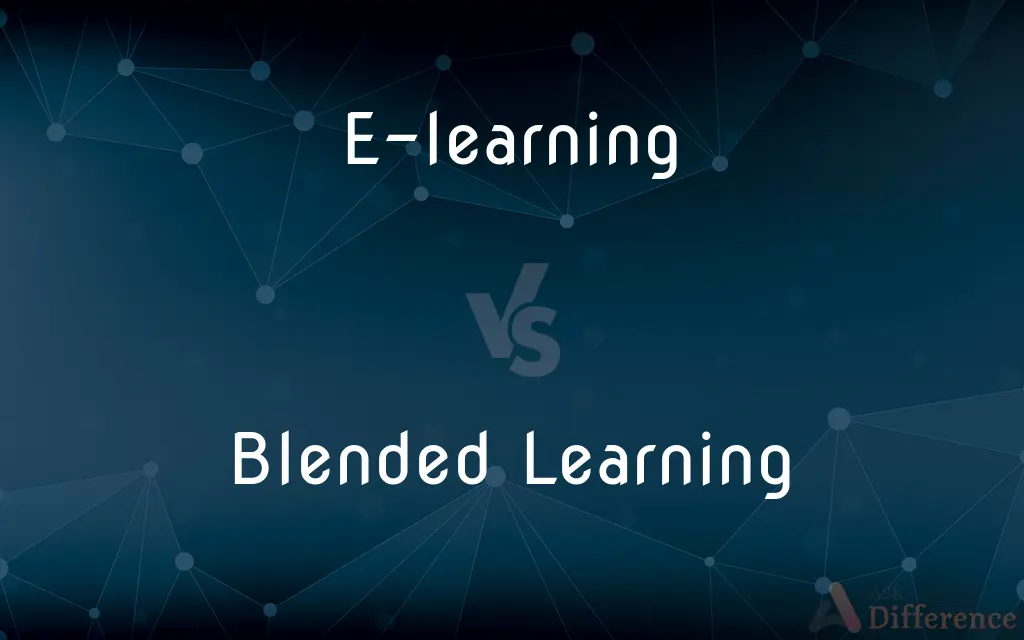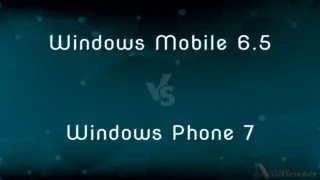E-learning vs. Blended Learning — What's the Difference?
By Tayyaba Rehman — Published on December 9, 2023
E-learning is fully online education. Blended Learning combines online with traditional in-person teaching.

Difference Between E-learning and Blended Learning
Table of Contents
ADVERTISEMENT
Key Differences
E-learning refers to education delivered entirely through digital means, typically on platforms or software designed specifically for online courses. This method has grown in popularity because of the convenience and flexibility it offers to learners. Blended Learning, on the other hand, merges this online approach with conventional classroom instruction.
E-learning platforms might include websites, apps, or specialized software where students can access their lessons, assignments, and tests. It eliminates the need for a physical presence in a classroom. Blended Learning, while utilizing these E-learning platforms, also incorporates traditional classroom sessions, ensuring that learners have face-to-face interactions with their instructors and peers.
E-learning offers learners the ability to study at their own pace, at any time, and from any location with internet access. It's particularly beneficial for those who might be geographically distant from educational institutions or have tight schedules. Blended Learning strikes a balance, offering the benefits of E-learning while retaining the personal touch and immediacy of traditional classroom sessions.
E-learning can sometimes lack the hands-on experience or immediate feedback that many learners benefit from. Blended Learning aims to fill this gap by integrating online learning with in-person instruction, thus giving students the best of both worlds. Both E-learning and Blended Learning aim to leverage technology to enhance educational outcomes but differ in their approach and execution.
Comparison Chart
Mode of Delivery
Fully online
Combination of online and in-person teaching
ADVERTISEMENT
Interaction
Primarily digital, often asynchronous
Both digital and face-to-face interactions
Flexibility
Maximum (learn anytime, anywhere)
Moderate (requires some in-person sessions)
Immediate Feedback
Might be limited or automated
More immediate during in-person sessions
Hands-on Experience
Often simulated or through digital tools
Combines digital simulations with real-world, in-class tasks
Compare with Definitions
E-learning
Web-based instructional experiences.
E-learning modules helped her grasp complex concepts easily.
Blended Learning
A mix of E-learning tools with conventional teaching methods.
Blended Learning solutions are perfect for those who appreciate both online resources and classroom discussions.
E-learning
Digital education delivered through online platforms.
John prefers E-learning because he can study from home.
Blended Learning
Merging digital courses with traditional classroom sessions.
Sarah enjoys Blended Learning as it offers both face-to-face interactions and online flexibility.
E-learning
Online courses offering self-paced learning.
E-learning allows Maria to balance her job and studies.
Blended Learning
Hybrid teaching combining the digital and physical realms of education.
With Blended Learning, students get the best of both online and offline educational worlds.
E-learning
Learning experiences delivered through digital devices.
E-learning tools have revolutionized distance education.
Blended Learning
Incorporating online modules with face-to-face instruction.
The school's Blended Learning program has been praised for its innovative approach.
E-learning
Education via electronic means, often without a physical classroom.
E-learning platforms like Coursera have a wide range of courses.
Blended Learning
An educational approach combining online and in-person instruction.
Blended Learning classes at the university offer both lectures and online content.
E-learning
Learning conducted via electronic media, especially via the Internet.
Common Curiosities
What is E-learning?
Digital education delivered entirely online.
Why might one prefer Blended Learning over E-learning?
To combine the flexibility of online learning with the personal interaction of traditional classes.
Does E-learning require specific software?
Often, it's delivered through specialized platforms or apps.
How is E-learning different from Blended Learning?
E-learning is fully online, while Blended Learning combines online and face-to-face teaching.
How do learners interact in E-learning?
Primarily through digital means, which might be asynchronous.
What is Blended Learning?
A mix of online and traditional in-person instruction.
Can E-learning offer hands-on experience?
It might be simulated or through digital tools, but it lacks the in-person aspect.
Is Blended Learning more time-consuming than E-learning?
It might require more fixed schedules due to in-person sessions.
Can E-learning be a part of Blended Learning?
Absolutely, Blended Learning incorporates E-learning components.
E-learning or Blended Learning?
E-learning might have lower overhead costs, but it depends on the specific course and platform.
Is E-learning more flexible than Blended Learning?
Yes, as it allows learners to study anytime and from anywhere with internet access.
Is E-learning suitable for all types of courses?
While it's versatile, some subjects might benefit from a blended or traditional approach.
Does Blended Learning offer immediate feedback?
Yes, especially during the in-person instructional sessions.
Can both E-learning and Blended Learning be personalized for students?
Yes, both approaches can offer personalized learning experiences, though the methods might vary.
How does Blended Learning benefit students?
It offers both the digital convenience and the immediacy of face-to-face interactions.
Share Your Discovery

Previous Comparison
Windows Mobile 6.5 vs. Windows Phone 7
Next Comparison
Hip Hop vs. PopAuthor Spotlight
Written by
Tayyaba RehmanTayyaba Rehman is a distinguished writer, currently serving as a primary contributor to askdifference.com. As a researcher in semantics and etymology, Tayyaba's passion for the complexity of languages and their distinctions has found a perfect home on the platform. Tayyaba delves into the intricacies of language, distinguishing between commonly confused words and phrases, thereby providing clarity for readers worldwide.
















































